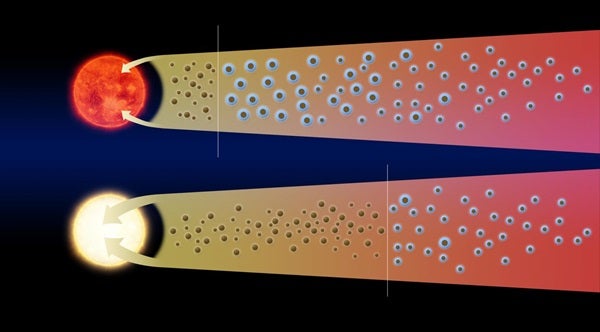It looks like winter is coming to a distant, still forming solar system thanks to the discovery of watery “snowlines.”
Snowlines are a ring of dust and debris where it is cold and far enough away from the host star where water, carbon monoxide, and other compounds condense into solid ice particles. They are a hot topic in the study of planetary formation as it is what may lead to the creation of planets in a system. Other snowlines have been found, such as the CO snowline, but this is the first instance of a water snowline as published in Nature.
The young star V883 Orionis (approximately 1,350 light years from Earth in the Orion Nebula Cluster) underwent a violent outburst, which heated the inner portion of the protoplanetary disk and in turn pushed the snowline out much further than normal. Because of this, astronomers were able to capture it with the Atacama Large Millimeter Array (ALMA) when normally it lies much too close to the star for even ALMA to resolve it.
The team who made the discovery were originally using ALMA to look for “signatures of disk turbulence and young planets in such disks,” says Zhaohuan Zhu, a postdoctoral fellow at Princeton University.
“Several theories exist to explain the sudden brightness of these sources. One of them predicts that the disk is so massive that it will start to develop spiral arms in disks. The theory also suggests that these spiral arms can sometimes fragment and form young planets,” says Zhu. “Thus, we were looking for these fragments (or protoplanets) in this disk. This disk is much more massive than most young protoplanetary disks and thus it has a higher possibility of developing spiral arms.”
Normally the heat from a new, young Sun-like star stops the freezing of any water molecules within a 450 million kilometer or three Astronomical unit (AU) radius. On the far side of this is where the snowline begins and a layer of ice can form on dust grains.
“We found that the dust becomes significantly smaller at the inner disk within the predicted water snowline,” says Zhu. “This dust distribution was predicted theoretically that, within the water snowline, ice is evaporated and small dust is released.
“This agreement gives us confidence that we have seen the water snowline for the first time.”
With the recent outburst from V883 Orionis caused by material in the disk falling onto the star, its brightness is approximately 400 times more luminous than our own Sun even though it is only 30 percent more massive. This brightness increase has pushed its snowline out to about 6 billion kilometers or 40 AU, which is similar to the placement of Pluto within our own solar system.
Within the snowline where water has been vaporized, the formation of the smaller, rocky planets, like Earth and Mars, are in favor due to the conditions. Where outside the snowline, conditions favor the creation of the gas giants, like Jupiter and Saturn, as the ice allows comets and similar objects to form which then guide the formation of the gas giants.
The fact that these snowlines can be blown to 10 times their normal radius is an important find in the study of planetary formation models. This may be the first observation of a common occurrence as these stellar outbursts are believed to be a normal stage of the evolution of planetary systems.
This observation might shed light on the formation on not only our solar system, but maybe all planetary systems with similar type stars to our Sun. This is what Zhu and his team intend on researching more, to see if the same phenomenon exists in all outbursting objects and if this leads to detection of the snowline.
“If every star undergoes outbursts, we need to keep in mind that the water snowline moves backward and forward all the time in the disk,” says Zhu. “Planets do not form in a quiet environment as some theories suggested before.”










